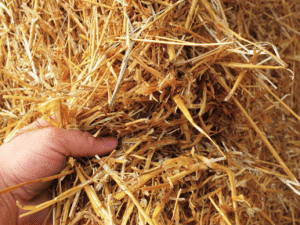
For me, the best straw to use is the straw that is local to you. Consider that you are building an energy efficient home. Does it make sense to truck straw across the country to your site because rice is better than wheat or vice versa? I don’t think so. As long as the bales are tight, uniform, dry, and of general high quality, I think you can use what is closest to your site. In fact, I even know of a guy who built a house using bales of old, compressed cereal boxes!
Yup, even that worked and his material was basically free since the recycling center (who did all the binding and compacting) was happy to give it away instead of process it. They saved money and he got free building materials (small transport fees did apply of course). So use what is high quality and close to you and you will be happy in the end.



10 Responses
My engineer has told me that the bale should weigh no less than less than 7lbs per cubic foot. This puts my local bales (14x18x39) at 40 lbs each; I have access to 42lbs bales and 32-pound bales. Does anyone have an opinion on the density issue, I mean, should I look for the heaviest bales possible and at what cost? it obviously affects insulative properties but to what degree and is the heavier the better? some local area farmers have built a compressing unit to reduce transport costs for straw and hay. It takes a bale and compacts it to half the original length, re-tying it and all! I here it is a little labor intensive..
Ryan,
It is important that the bales be as dense as possible for a couple reasons. The first, as you mentioned above is the insulative value of the wall. This concern is not that great because even a fairly “loose” wall will be well insulated. The second, and perhaps more important reason, is that the bales will start to sag during installation if they are not dense enough. The very weight of the bales above will compact, unevenly, the bales below. This creates all kinds of problems. The bales I like best weigh 45 pounds and are uniform is shape and size (14x18x40). Anywhere with a density of 7 lbs/cu ft and up is a good idea. Again, super compressed bales are probably not worth the effort what with the diminishing returns and all.
Thanks Andrew, this is what I was looking for, Following that line if a person had many sources of bales of equal dimension would it not be beneficial to put three or four courses of 42lbs bale and then use 32lbs bales to finish the wall putting less overall weight on the bottom courses?
Ryan,
I would not bother using two different densities. I think it would be more frustration than it is worth.
Do you stack the bales with the straw vertical or with the straw laying horizontal??
Hi Joe. I lay my bales “on the flat”. In other words, so that the strings are on top and the bale lies such that the length of the bale is roughly 36″, the width of the wall is 18″ (2-string bale) and the height of the bale course is 14″ or 16″ depending on the bale type.
IS this still the case? or have futher studies shown that different types of straw are more suited? Ie, Wheat vs Rapeseed/Canola ?
Even today, the article’s main point remains true – “the best straw to use is the straw that is local to you.” There can be slight variations from one kind of straw to another, but ultimately, you want bundles of air pockets that provide insulation. Many different types of straws meet this requirement and are used for building purposes. How straw is cut, baled, and stored is another blog post.
I am unaware of any studies that determined if one type of straw is better as insulation than another. Please share if your search discovers studies on this subject. We’d love to know what they concluded.
Yes I agree on your firs pint and Id like to see more research on density/moisture content/straw length/orientation etc. However I wasn’t sure if different silica content etc within the different types of straw were more efficient or better equipped for differing climates. – will share if I come across anything
Caleb, Checkout this article we recently posted. It provides some insight along the lines you are interested in. Choosing Straw Bales for Home Construction